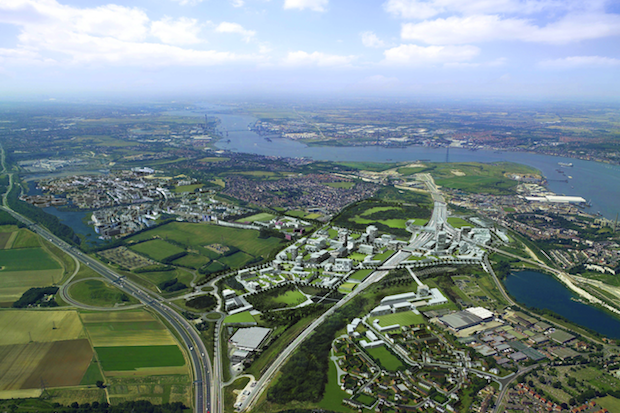So, the government plans to create a new ‘garden city’ in Ebbsfleet, Kent, with 15,000 new homes. Yesterday’s announcement by George Osborne has been widely praised. The local Tory MP is enthusiastic. Boris Johnson tweets that it’s ‘great news.’ The best critique Ed Balls can muster is that it’s all ‘too little, too late.’ Labour wants 200,000 ‘new homes’ (that emotive mantra) per year by the end of the decade. I don’t live in Kent. This garden city isn’t in my back yard. So why, when I heard this news, did my sentimental heart sink?
‘New homes’ is such a sly use of words. How could anyone be against new homes? What this phrase really means, of course, is lots and lots of brand new houses. However the term that makes me despair is ‘garden city’. Have you ever heard such a contradiction in terms? A garden is not a city. A city is not a garden. And far from being a modern solution to a modern overcrowding problem, this misguided concept is actually an Edwardian notion, dreamt up when Britain’s urban poor still lived in squalid back-to-backs.
The idea of garden cities was conceived by Sir Ebenezer Howard, a social reformer born way back in 1850. Howard’s day job was working for Hansard, but, like a lot of well-meaning, wrong-headed Edwardians, he harboured daydreams of utopia. He travelled to the New World. He read Emerson and Walt Whitman (always a dangerous thing to do). In 1898, he published To-Morrow – A Peaceful Path To Real Reform, republished in 1902 as Garden Cities of To-Morrow. Garden Cities of To-Morrow argued that there were three main ‘magnets’ of population: town (‘closing out of nature, social opportunity’); country (‘lack of society, beauty of nature’) and Howard’s own pet project, town-country: ‘beauty of nature, social opportunity, fields and parks of easy access, low rents, high wages, low rates…’ And so on.
Howard had a hand in England’s first garden city, Letchworth, built after the First World War. Visiting Letchworth today, a century later, its inherent flaws are clear to see. The original conurbation is pleasant, and still works, after a fashion, but, fatally, Howard’s utopian vision predated the mass production of the automobile. His Garden City is now enveloped by a bland hinterland, neither town nor country, dominated by the motor car. Visit Stevenage, built after the Second World War, and it’s the same story. The place is carved apart by roads and roundabouts. It’s almost impossible to walk around. The public spaces seem anonymous. The only bit that works at street level is the historic old town at its centre. Stevenage’s new garden city hasn’t grown organically, like our ancient towns and cities. It’s been superimposed.
Like Howard, one hundred years ago, Osborne envisages a rail hub for his garden city, the ‘fantastic infrastructure’ of the local high speed line (expect lots of ghastly future garden cities, all along the new high speed line from London to Birmingham and beyond). Yet sadly, like Ebenezer Howard, Osborne’s high speed utopia is powerless against the motor car. Rail travel may work for trendy urbanites, but for the aspirational folk who dream of a detached box house (sorry, ‘home’) in Ebbsfleet, two cars in the drive (his ‘n’ hers) is a key part of the petty bourgeois package. Britain’s latest garden city may start off as a tidy post-industrial paradise, but it will end up like all garden cities – an island of planned housing in an ocean of suburban sprawl.
William Cook also writes for the Independent and Conde Nast Traveller. His latest book, One Leg Too Few – The Adventures of Peter Cook & Dudley Moore, is published in paperback by Arrow in May.






Comments